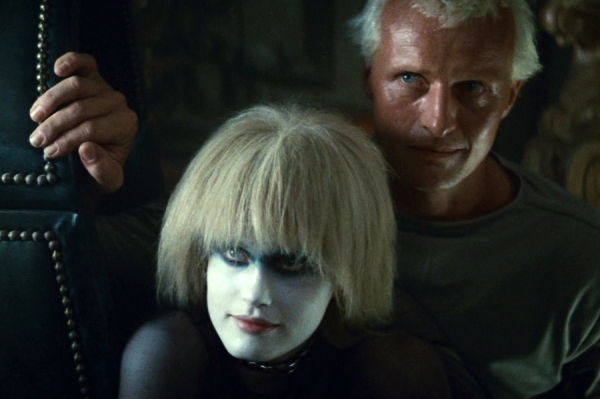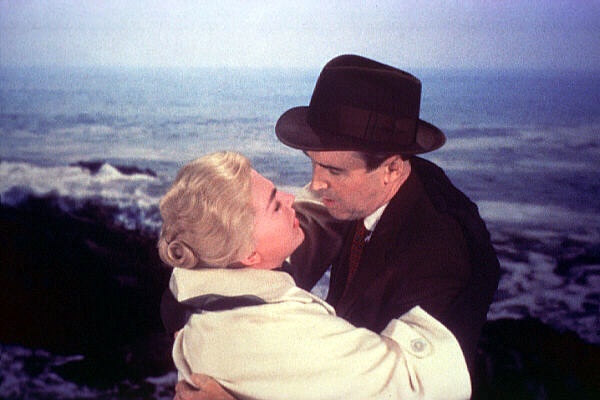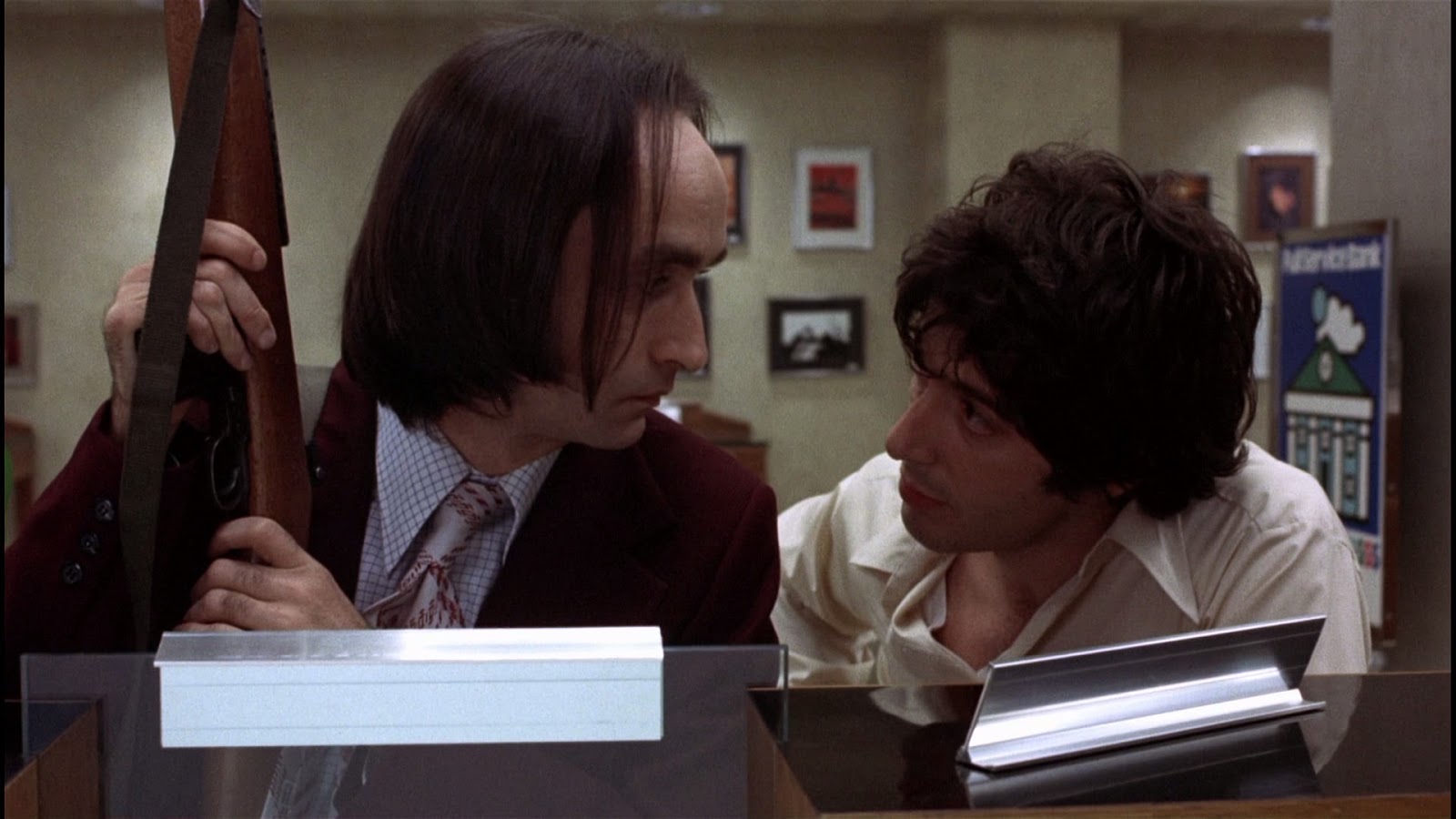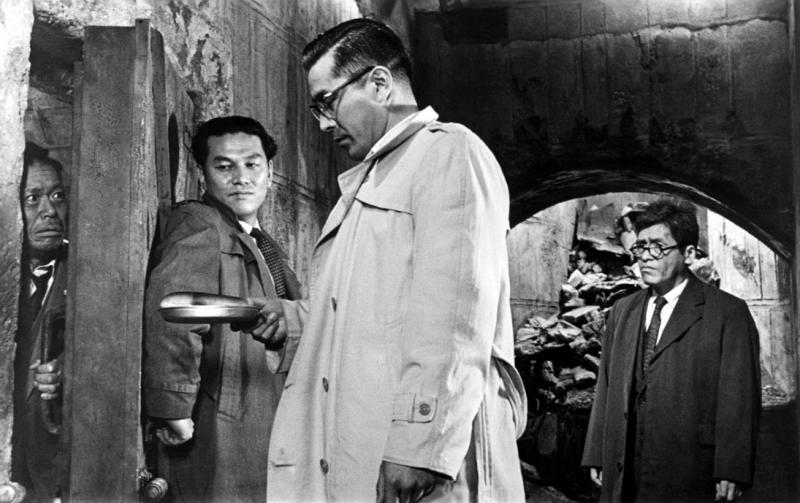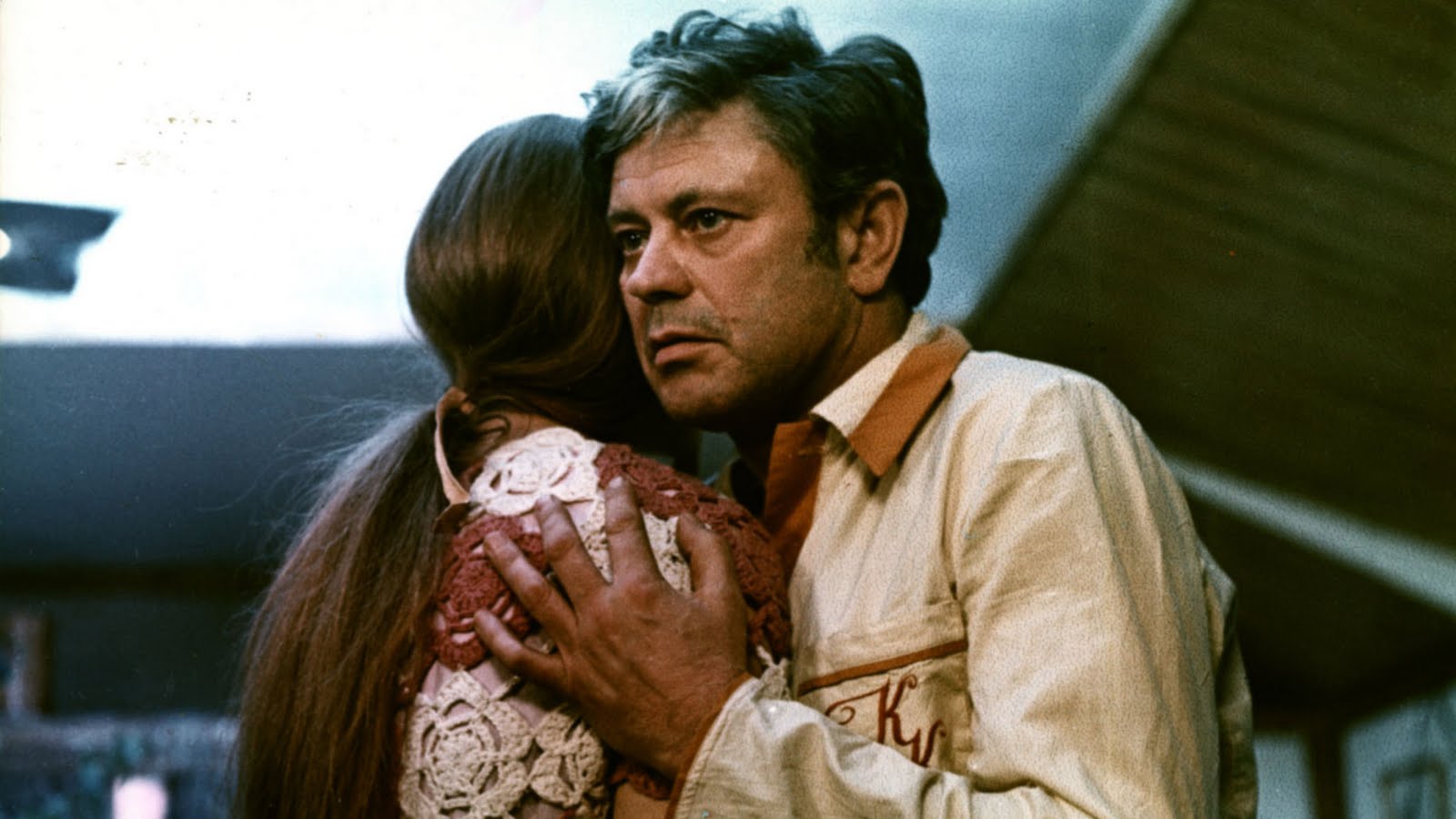6. Blade Runner (1982, Ridley Scott)
This is purportedly the example Christopher Nolan offered to his cast and crew to illustrate the kind of movie they were going to make out of Batman Begins. It was also his favorite movie of all time as a college student. And before that, it was discovering the Ridley Scott connection between Blade Runner and Aliens that made him decide that he wanted to direct films.
Biography aside, the atmosphere of Blade Runner is important to understanding the type of cinema illusion Christopher Nolan wants to impart to the audience. It is what he describes as “that feeling that there was this whole world outside the frame of the scene…That’s something I’ve always tried to carry with me. Every film should have its own world, a logic and feel to it that expands beyond the exact image that the audience is seeing.”
In the future, mega-corporations use bio-engineered humanoids called Replicants to perform slave labor on the off-world colonies. They are banned from Earth and when they come, special police operatives called Blade Runners kill them. Rick Deckard (Harrison Ford) is a retiring Blade Runner coerced by his former Boss to do one last mission.
Four Replicants at large are responsible for the death of a police officer. Having learned that their model’s lifespan is four years, they are seeking out their creator in Los Angeles to induce him to extend it. Deckard falls in love with another Replicant, one implanted with false memories, and has to choose how far he is willing go to fulfill his duty.
The neo-noir elements are established firmly in this cult classic sci-fi film. Harrison Ford’s Deckard is an anti-hero trying to make decent decisions in a moral vacuum of a city. The conflict between institutions of power and the beings who are byproducts of that power inform the battles fought in Christopher Nolan’s Batman movies and Inception. Blade Runner showed the way neo-noir creates a world outside the frame.
7. Vertigo (1958, Alfred Hitchcock)
San Francisco detective Scottie Ferguson (Jimmy Stewart) is forced to retire after his fear of heights causes the death of a fellow officer. He accepts a private job following the movements of his old college friend’s wife, Madeleine (Kim Novak). She is obsessed with her dead great-grandmother who committed suicide at her same age.
Scottie saves her from a suicide attempt and the two start to fall in love. She disavows memory or intention of committing suicide, claiming instead to be plagued by strange dreams and possessed by the ghost of her great-grandmother. Scottie tries to dissuade her of the belief by taking her to the San Juan Bautista, where her dream memories are located.
When she rushes up the tower to jump to her death, Scottie is stricken helpless by his acrophobia. It’s only much later that Scottie, in a state of recovery but obsessed with Madeleine, discovers that all is not what it seemed to be.
Vertigo is a stalker film before stalking was thought of as a crime. The fact that Scottie was hired to follow Madeleine does not discount the sexual tension of his gaze. The story suggests that obsession is contagious, as Madeleine’s obsession with her great-grandmother transfers to Scotties obsession with Madeleine, fueled by the long hours of following her throughout San Francisco.
Hitchcock is at the height of his power in Hollywood when this film was made, and much like Christopher Nolan he is obsessed with the darker side of humanity; obsession, madness, greed, and the slippery hold one has on reality are all themes shared by the two directors of English extraction.
Hitchcock was the master instructor to legions of filmmakers on the power small details exert to twist the plot in surprising new directions, like the necklace in Vertigo that enlightens Scottie to the trick that has been played on him, or the spinning top at the end of Inception. The first necessity in the school of Hitchcock is that character must never be who they seem. Someone who isn’t running from something or concealing something from their past is not a very promising character.
But what makes Vertigo so essential to the formation of Christopher Nolan’s film worlds is the way the camera becomes a participant for the audience. Rear Window is a strong case as well, but the camera is too much a character in that very excellent film.
Christopher Nolan does not make movies about people using cameras, but he does use the film camera to carry the audience along for the ride. A key example is the shot that walks us into a room behind a character. It does the work of an establishing shot and also conveys how a character enters the situation on the other end of the room.
The audience is encouraged by these decisions to keep close to the point-of-view of the players in the drama—an essential matter of dramatic tension when the rooms of a story form a maze to disorient and disturb the audience.
8. Dog Day Afternoon (1975, Sidney Lumet)
Somewhere between police procedural and character-study there is Dog Day Afternoon, set in a New York City on edge after the Stonewall riots, when anti-establishmentarianism was in the air and exploitation media was being practiced in different ways in the porn houses in Times Square and on the local news.
It is August 22nd, 1972 and two men attempt to rob the Brooklyn branch of the Chase Manhattan bank. The police barricade the place as the robbers take hostages and a media circus ensues. One of the robbers attempts to negotiate. He ends up spending 6 years in prison while his partner gets gunned down by the FBI.
That’s where the movie ends, but the real life bank robber made enough money selling the movie rights to his life to pay for his partner’s sex change, revealed to be his character’s motivation for attempting the robbery in the first place. His name was John Wojtowicz, but in the movie made from that deal his name was changed to Sonny. He was played by Al Pacino.
Al Pacino was not looking to do another movie when he was approached to star in Insomnia. When he watched Christopher Nolan’s Memento, he knew he wanted to work for him. He played Los Angeles detective Will Dormer, who along with his partner Hap Eckhart (Martin Donovan) fly to Alaska to help the local police solve the murder of a seventeen-year old girl. The land of the midnight sun does not suit his biological clock and the inability to sleep affects his ability to think.
Both films are carried by the dramatic spectacle of Al Pacino’s disintegration. Both use the moody character study element to distract and enthrall audiences while the police procedural proceeds to build towards climax.
For a director whose reputation was minted in the stylistic bravado of Memento and continues to be lauded in most of his other films, Insomnia feels out of sync. But as Dog Day Afternoon’s director, Sidney Lumet once said of style: “the important thing in style is stripping away everything except what that picture needs.”
The influence was not limited to Insomnia. In conceiving the terror that would be the catalyst for the plot of The Dark Knight, Christopher Nolan took permission from Dog Day Afternoon’s chilling realism. Namely, that the scarier robbery is the one conducted in broad daylight when the bank is open for business and thus full of civilians.
Batman is a vigilante, so law enforcement for him is a personal matter, a private passion that requires a certain level of concealment. Sonny is a wildcat robber on the other side of the law, but like Batman he plays out the mini-dramas of moral decision-making in a way that is bigger-than-life. As Christopher Nolan has said, “We all wake up in the morning wanting to live our lives the way we know we should, but we usually don’t, in small ways.”
9. The Bad Sleep Well (1960, Akira Kurosawa)
Along with High & Low made three years later, Akira Kurosawa went to the dark places in the post-war society of Japan’s corporate culture to tell a tale anathematic to his more humanist tendencies. The Bad Sleep Well is a suit-and-tie noir about an individual’s bid for revenge and justice against a system of mutual protection and craven greed.
Nishi (Toshiro Mifune) has married the crippled daughter of the Vice President of a construction company. Press and wedding guests gossip about the handsome young man’s ulterior motives until the police arrive to arrest two junior corporate executives for bribing government officials. Like a previous scandal involving the company, the investigation is interrupted when the junior officials commit suicide to protect their bosses.
Nishi is able to stop one disgraced executive, assistant officer Wada, from jumping into an active volcano by convincing him that his superiors are not worthy of his sacrifice. It is revealed that Nishi is the secret son of another executive whose death ended the earlier police investigation. He is certain that his father did not commit suicide, rather he was killed to prevent him from cooperating with the police. Nishi has vowed revenge on the leaders of the construction company responsible for his father’s death.
At times the acting veers into camp. What resuscitates it is the utter blackness of this movie’s hope for humanity. The shadowy reaches of corporate power stay off-screen at critical moments, putting one to mind of the conspicuous absence of Thomas Edison in The Prestige.
Nikola Tesla is brilliantly played by David Bowie. He provides an essential assistance to Victorian magicians Robert Angier (Hugh Jackman) in his fierce rivalry with Alfred Broden (Christian Bale) after their biggest trick together goes fatally wrong. The desire for revenge does not touch the corporate lords in either film, though they are compelled to order extreme countermeasures to suppress upstarts like Tesla and Nishi.
Robert Angier’s competition with Alfred Broden is personal as well as professional, but the obsession he has with uncovering the illusion—not just besting it with slick showmanship—drives him to his own extremes.
10. Solaris (1972, Andrei Tarkovsky)
On the other side of the sci-fi space epic galaxy from Kubrick’s 2001: A Space Odyssey is the soviet meditation on grief and the impact of space exploration on human understanding—Solaris. Equally slow-moving but more emotionally engaged in the personal costs of space exploration, Solaris is a closer antecedent to Interstellar than 2001.
Both movies have a widower protagonist who we meet in rural surrounds on Earth. Both protagonists weigh the years of life on earth lost to space travel. In Solaris, Kris Kelvin must say goodbye to his niece and father. Coop, in Interstellar, leaves behind a daughter, a son, and a father-in-law. While the bigger cost in Coop’s case is the rage of his daughter against his leaving, in Solaris it is the inexplicable re-appearance of Kelvin’s dead wife that ravages.
The cosmonauts on the space station above the ocean planet of Solaris have been afflicted with “visitors”, apparitions from their past that disturb them. Kelvin’s wife is one such visitor, and she gradually gains the capacity to exist away from Kelvin’s presence. One of the scientists theorizes that Solaris is a sentient planet. After they blasted it with radiation the visitors began to appear.
It is also theorized that it is possible to communicate their desire for the apparitions to stop. Eventually this works and islands begin to form on the surface of the planet. Like Coop in Interstellar, Kelvin must choose whether to return to Earth or go in pursuit of a new life. The ending is in many respects the same as Inception.
Like the strange watery planet of Solaris, Coop’s crew encounter two planets where water features extreme manifestation. On the first there are waves taller than skyscrapers and on the second the clouds have frozen into a second shell around the planet’s surface. However, it is the worlds that are shared between people that form the crux of Interstellar and Solaris. Coop and his daughter Murph have a connection that transcends space-time.
Kelvin’s grief over the suicide of his wife is the very power that induces the sentience of Solaris to recreate her out of his memories. In both cases, memory is as much an affliction for the suffering space travelers as it is their guide back to humanity. When faced with the unknown, it is the conflicting impulses to preserve individuality and annihilate the barriers of separateness that work upon the human soul.
Suspecting that the world might not be real is not as prevalent in this list of films as perhaps suspecting that you, the character, might not be real. Solaris is the exception, on a grand scale. Perceptions of reality and their malleability is a theme striking to the very core of what cinema is and can be. Whether or not that is pure cinema is beyond the scope of this list. Perhaps it is the traditionalist influence in the forward-thinking filmography of Christopher Nolan that insists on playing with time and space.
Author Bio: Chris is a 29 year old grant-writer for a meditation retreat center in the Colorado Rockies, but he came here first to make short videos about the center. His favorite directors are Federico Fellini, Kurosawa, Billy Wilder, the Coen Bros., Stanley Kubrick, and Edgar Wright.
